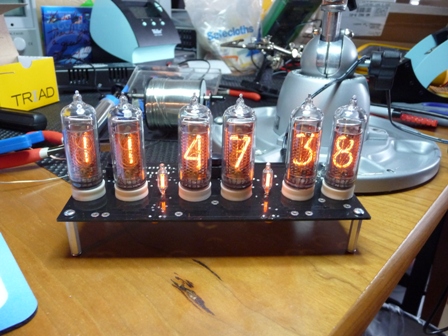From my alter-ego – the other half of my degree is in electronics – I usually blog this stuff on my separate electronics blog but this is so cool I wanted to share with the wider audience…
A couple of weeks ago I built a Nixie tube clock kit that I got from Peter Jensen at TubeClock.com. Initially it didn't work properly when I powered it up but this morning I debugged it and found a short between two legs of one of the surface-mount high-voltage driver chips. Fixed that and it works perfectly!
Click below for a 1024×768 image.
The clock uses six IN-14 Russian Nixie tubes running at 180V DC and tells 24-hour time. Nixie tubes were introduced in the early 1950s and provided the display for things like multimeters, calculators and the Apollo guidance computer before LCDs and LEDs were invented.
I uploaded a short video showing the seconds and minute digits changing – I love the soft glow of the digits. Check out the video here.
Next project is building a Theremin…


5 thoughts on “Nixie tube clock”
I remember Nixie Tubes very well. The combat information center on my last ship had oh 20 or 30 thousand of the things :). A few dozen are cute, a few thousand make a great hand warmer on a cold day, 30K of them will melt a heart of stone and tax a very large A/C plant.
Want. You should set up an opensky store :)
Paul,
I always enjoy hearing of your electronics projects. I remember building digital clocks in days gone by – lots of fun. Mine were LED displays – Nixie tubes are trickier with the higher voltage requirements. Bravo!
I also remember Nixie tubes in a ham radio receiver as the tuner frequency display. Where LED displays are all on one depth plane, the 10 separate Nixie tube neon digits are each slightly separated in depth from each other, so that as they change (seconds ticking by in your clock, or dialing in a new frequency on the ham receiver), you can see the slight changes in the depth of where the next digit appears. Your video shows that as well. Kind of cool looking, and very retro!
Prior to CMOS "clock on a chip", I also remember a few related 7400 TTL logic chips – 7441 BCD to decimal (for use with Nixie tubes) and 7447 BCD to 7 segment (for use with LED or LCD 7-segment displays).
My favorite Nixie tube memory is the atomic bomb in the movie "Goldfinger", counting down towards explosion at Fort Knox. After James Bond fights off Oddjob and tries unsuccessfully to disable the bomb, an engineer calmly steps in and deactivates the bomb with "0:07" seconds left to detonation.
Thanks for stirring up the memories,
Scott R.
Why is nixie a seven segment display
They’re not – they’re Nixie tubes.